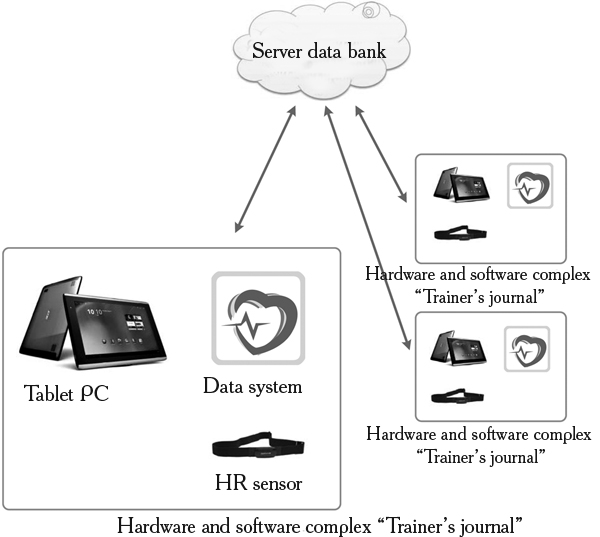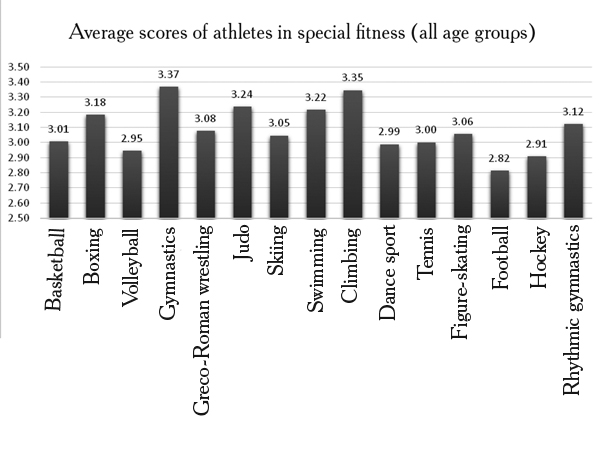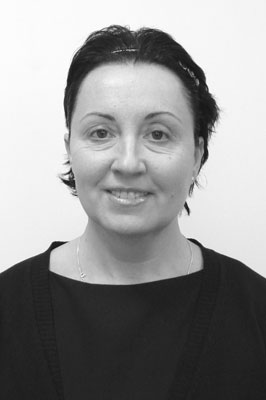Organization of Physical Health and Physical Fitness Monitoring of Young Tyumen Athletes
Фотографии:
ˑ:
E.A. Korotkova, professor, Dr.Hab.
Institute of physical culture of Tyumen state university, Tyumen
N.B. Soloshenko, M.V. Alekseeva, M.A. Naumova
Department of sport and youth policy of Administration of the city of Tyumen
Key words: physical development, general and special physical fitness, monitoring, software, project efficiency criteria, innovation environment.
The implementation of the strategy of system innovations in Tyumen, initiated by the Department of sport and youth policy of the city administration was started from the project “Monitoring of physical health and physical fitness of young athletes”.
The top priority of the project was to make monitoring an ordinary thing in the industry, for efficiency of any further innovation is to be estimated adequately – from the initial level and in dynamics. Therefore we had to work with the general sample - 11000 thousand athletes aged from 6 to 17 years - and examine 16 sports. However, a research was to be organized: to work through the package of regulatory documentation; to engage and instruct a large number of experts, to prepare research equipment; to master software, etc.
Apart from the key scientific-practical task of improvement of the learning and training process of young athletes, protection and strengthening of their health, we were to suggest managerial decisions, facilitating more efficient organization of the learning and training process of young Tyumen athletes.
The purpose of the study was to design and validate the project of organizing the monitoring of physical health and physical fitness of young Tyumen athletes.
Materials and methods. The project was expected to last for one year and at the first phase 7800 young athletes were subjected to the integrated examination, which included testing of physical development, general and special physical fitness.
The project was started in February of 2013 with signing of Cooperation Agreement between the Department and Tyumen State University. Then the communication map of the project; the orders of the Department of Sport and Youth Affairs and of the Institute of Physical Culture and Children and Youth Sports Schools; Documents for the implementation of the household works and payment for the work of students and graduate students conducting testing were developed and approved.
In order to implement the project at the department of theory of physical education in the Institute of Physical Education of Tyumen State University (IPE TSU) seven research groups totaling 70 people were created and a scientific seminar for training postgraduate students to tests and safety trainings when testing children were conducted.
Monitoring of physical health and physical fitness of athletes was carried out using a data system, which also included an automatic data transmission to a specified server. The overall architecture of the complex used in the monitoring is presented in Fig. 1.

Fig. 1. The design of the hardware and software complex (HSC) in the form of tablet PCs with preinstalled "Trainer's Journal" software.
The content of the test of athletes included six tests on general physical fitness (30 meter running, pull-ups for boys, dip ups for girls, standing long jump; lean forward with straight legs; 3x10 meter shuttle run, 6-minute running) and two tests to assess special physical fitness from each type of sport; seven tests to determine physical condition (growth, body weight, vital capacity, strength of right and left hands, blood pressure, resting heart rate).
As a result of the study we expected to get: rating of test results of all athletes in general and special physical fitness, strength index and birth-death ratio; estimation of general and special physical fitness based on levels (high, above average, average, below average, low) and kinds of sport; average rating of special fitness of boys and girls based on age groups and kinds of sport; rating of Children and Youth Sports Schools based on kinds of sport in all tests and based on age groups (identifying Children and Youth Sports Schools with high and low indices); assessment of strength index and birth-death ratio.
Results and discussion. The indices of young athletes who showed above-average and high results in general physical fitness and physical development were significantly higher in comparison with other pupils.
As for special physical fitness (SPF) (the results of special tests were compared with the standards of the programs of Children and Youth Sports Schools on the respective sports), 40,4% of boys showed average results and the results of 30,6% were higher than average; the results of the majority of girls (39%) were higher than average, and 30% had average results. However, 12% of boys and 15% of girls had good results and only 10% of the entire sample had their results at the low and below average levels.
For the first time we determined the level of special physical fitness of athletes in every sport in specific tests. Later, these criteria will play the leading role in evaluating the effectiveness of innovations and other improvement of the training process.
Further on, using the standards to assess the level of physical development of children aged 6 to 17 years, we have assessed the level of physical development of young athletes and found that 2% of the athletes correspond to the high level, 24% - above the average; 57% - average; 17% - below average. Comparing these results with the assessment of the level of physical development of children not involved in sport, we can say that athletes are significantly better developed physically than children not involved in sports. It is enough to say that there were no cases corresponding to the low level of physical development.
The average score in SPF for boys and girls based on age groups and kinds of sport was used to identify those sports where SPF is better implemented. The results are shown in the diagram of Fig. 2, where the surveyed sports are lined up according to the rating and it is shown that climbing and judo are leading in all age categories (Fig.2).

Fig. 2. Rating of sports based on average indicators of special physical fitness of young athletes in Tyumen (all age groups)
By the age of 15-16 a fairly high level of SPF is detected in basketball players and swimmers.
At the same time it should be noted that the relatively low level of special fitness has been registered in basketball players aged 8 years, volleyball players aged 12 and 17 years, children with weak health come to tennis at the age of 6 years, football players aged 9-10 years have very poor results in SPF; hockey players aged 11-12 years have the low level of special fitness.
The rating of Children and Youth Sports Schools in all tests and indicators depending on kinds of sport and ages was determined to identify the leading schools, i.e. those where the training process was arranged well enough and schools outsiders.
In all the tests of the level of physical fitness, the Specialized Children and Youth Sports School of Olympic Reserve № 33 is unambiguously the leading school in Tyumen.
In addition, one should noted good physical fitness of boxers of the Children and Youth Sports School "Priboy", gymnasts of the Specialized Children and Youth Sports School of Olympic Reserve № 1, hockey players and rhythmic gymnasts of the Specialized Children and Youth Sports School of Olympic Reserve № 3.
The findings give rise to concern: nearly 40% of athletes have low and below average results. The researchers associate it with poor development of the overall physical working capacity of most of young athletes. In particular, general endurance level and lung capacity influence the indices of overall physical working capacity.
Conclusions. The analysis of the results has revealed the following capabilities of the proposed innovative project.
1. Thanks to joint efforts of specialists of the Department of Sport and Youth Policy of Tyumen, scientists of Tyumen State University - executors of the project, as well as managers of Children and Youth Sports Schools and trainers we have managed to establish important connections for further introduction of innovations in the field of physical culture and sport: to change the values and perceptions of all the project participants, focusing them on the need to modernize the training process of young athletes. Thereby we have managed to solve the tasks of creating an innovative environment, the need for improvement of trainers’ professional skills, form a unified informationally accessible environment for officials, trainers, parents and athletes.
2. Implementation of a complex of informational and analytical means for monitoring of physical and sports fitness in sports school enables:
- to analyze and estimate automatically athletes’ general fitness level;
- to calculate and correct standards and evaluation of test results on the basis of statistical data processing with an automatic update of all systems;
- to design and analyze the generalized dynamics of sports skill development in athletes in general, as well as based on age and certain sports in particular;
- to create a single database on promising young athletes;
- to develop and implement a rating system of general and special fitness in various sports.
The use of diagnostic means in the form of a computer program can increase the level of control and information processing in data acquisition about child's predisposition to a certain sport and the dynamics of fitness levels. "Trainer's Journal" helps not only a trainer but also a child and his parents to control fitness level, which significantly enhances the child's sports motivation.
3. In each study of such a type we have to compare the average test results with standard federal norms in sports programs. Such a comparison is incorrect, since only the regulated norms should be compared with each other. Therefore, regional standards of physical fitness should be developed for all ages. We are to develop them by the end of the project (fall 2013).
Working with the new database provides the following:
- analysis of the individual rating of athletes in the city;
- development of model characteristics of talented athletes according to the results of their tests;
- identification of leading trainers;
- development of versatile sets of exercises for different sports to significantly increase the level of general and special fitness;
- modification of the continuous monitoring system, introduction of the qualitative criteria of improvement of the sphere of physical culture and sport;
- design of practical recommendations on planning of physical load;
- modernization and approval of the program of advanced training courses for trainers in various sports;
- providing access to the unified information database on physical health of young athletes of Tyumen for the head of the city, director of the Department of Sports and Youth Policy for the purposes of making management decisions, development of many educational and social projects and the regulatory framework for physical fitness.
References
- Golichenko, O.G. Russian national innovation system: state and ways of development / O.G. Golichenko. – Moscow: Nauka, 2006. – 396 P. (In Russian)
- Goldstein, G.Ya. Strategical innovation management: teaching aid / G.Ya. Goldstein. – Taganrog: publ. h-se of TRTU, 2004. – 267 P. (In Russian)
- Zav’yalova, T.P. Guidelines for monitoring of physical fitness of preschool children: study guide / T.P. Zav’yalova, I.V. Starodubtseva. – Tyumen: Vector Book, 2004. – 30 P. (In Russian)
- Korotkova, E.A. Innovation development of the sphere of physical culture and sport of the Tyumen region: problems and ways of formation / E.A. Korotkova // Teoriya i praktika fizicheskoy kultury. – 2002. – № 1. – P. 2-8. (In Russian)
- Korotkova, E.A. Innovation development of the sphere of physical culture and sport of the Tyumen region: problems and ways of formation / E.A. Korotkova // Teoriya i praktika fizicheskoy kultury. – 2011. – № 1. – P. 10-13. (In Russian)
- Korotkova, E.A. Innovation management in education/ E.A. Korotkova // Fizicheskaya kultura: vospitanie, obrazovanie, trenirovka. – 2010. – № 1. – P. 2-4. (In Russian)
- Korotkova, E.A. Social effects of innovations in the sphere of physical education of the rising generation / E.A. Korotkova // Philosophic and sociological issues of physical culture and sport: Proceedings and reports of the “round table” with internat. part., March, 20 2012, RSUPhCSYT (Russia, Moscow). – Moscow: Fizicheskaya kultura, 2012. – 68 P. (In Russian)
- Khromin, E.V. The concept of integration of basic and extended education of comprehensive schoolchildren: teaching aid / E.V. Khromin, I.I. Suleymanov, V.G. Khromin, V.N. Potapov. – Tyumen: Vector Book, 2001. – 20 P. (In Russian)
- Khromin, E.V. Increasing efficiency of physical education of schoolchildren based on their training specialization / E.V. Khromin // Teoriya i praktika fizicheskoy kultury, 2005. – №8. – P. 5-6. (In Russian)
- Khromin, E.V. Training specialization as one of modern theoretical-methodological approaches to improvement of physical education of schoolchildren / E.V. Khromin // Fizicheskaya kultura: vospitanie, obrazovanie, trenirovka. – 2001. – №3. – P. 21-26. (In Russian)
- Khromin, E.V. On the strategy of system innovations in health formation of the rising generation / E.V. Khromin, E.A. Korotkova, A.E. Stepanov // Fizicheskaya kultura: vospitanie, obrazovanie, trenirovka. – 2013. – № 4. – P. 2-5. (In Russian)
Author’s contacts: ifk-tofv@mail.ru




 Журнал "THEORY AND PRACTICE
Журнал "THEORY AND PRACTICE